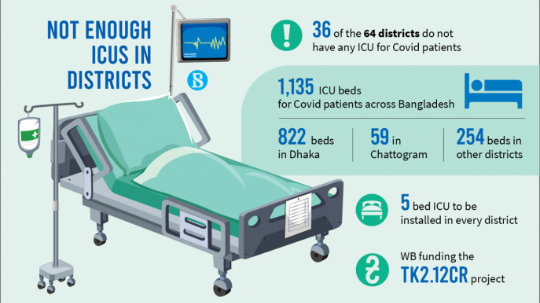One Year After PM’s Order, District Hospitals Still Lack ICUs
Covid patients suffer as 36 of 64 district hospitals do not have ICUs
Tawsia Tajmim | 28 June 2021
The Covid positivity rate is now hovering between 30% and 32% in Naogaon, a bordering district of the country. Amid the wide spread of infection, many Covid patients have become critically ill. Since Naogaon General Hospital does not have an intensive care unit (ICU), it is referring patients to the hospitals in Rajshahi and Bogura.
The situation in Naogaon is not unique. About 36 out of 64 district hospitals do not have an ICU for Covid patients.
In many cases, critical patients are transferred to healthcare facilities in divisional headquarters or tertiary hospitals for intensive care. The delayed treatment often leads to deaths that can be otherwise avoided.
Experts say that if ICUs had been set up on an emergency basis in every district town following the prime minister's directive a year ago, Covid fatality could have been lower.
In the meantime, a third wave of the pandemic has reached the remotest corners of the country, increasing the death risk amid the absence of ICU support.
According to the Directorate General of Health Services, there is no ICU for Covid patients in 5 districts of Dhaka division, 8 districts of Chattogram, 6 districts of Rangpur, 2 districts of Sylhet, 4 districts of Barisal and Khulna each, 6 districts of Rajshahi and 2 districts of Mymensingh division.
Prof Nazrul Islam, noted virologist and member of the National Technical Advisory Committee on Covid-19, told The Business Standard that the Covid toll in district hospitals was on the rise.
"I think a separate body has to be formed to deal with Covid-19."
Under the World Bank's Covid-19 Emergency Response and Pandemic Preparedness project, each district will have a 5-bed ICU to be set up at a cost of Tk2.12 crore. About 3,500 health workers will also be trained, so they gain skills to provide intensive care.
Project Director Azizur Rahman Siddiqui said the Public Works Department had planned to set up ICUs in 43 districts.
The construction designs of 13 units were readied a month ago. It will take about one and a half months to complete the construction, after which medical equipment will be brought with help from Unesco.
"When the ICUs are ready, we will give training to health workers," Azizur said.
No initiative to solve manpower crisis
Meanwhile, two ICU beds have been sent to Naogaon from the Central Medical Stores Depot, but those are useless without anesthesiologists or critical care medicine specialists and nurses.
Officials from the Directorate General of Health Services said ICU beds could not be set up at district hospitals due to the manpower crisis.
"We have enough ICU beds and ventilators. But we cannot put those to use because of the inadequacy of skilled manpower. The number of anesthesiologists in the country is low, and the lengthy recruitment process is delaying their appointment," said Dr Farid Hossain Miah, director (hospitals and clinics) at the health directorate.
Debabrata Banik, president of the Bangladesh Society of Anesthesiologists, said that more than 1,000 anesthesiologists were now working in the private sector and the government could provide ICU services to critically ill patients by recruiting them on an emergency basis.
Three months back, Prime Minister Sheikh Hasina directed the Cabinet Division to appoint 450 anesthesiologists, but due to bureaucratic tangles, appointments have not been done yet.
"The posts of junior consultant will be filled up by those who have completed post-graduation in anesthesia. If we give them seven days' training, they will be able to manage Covid patients."
News Courtesy:
